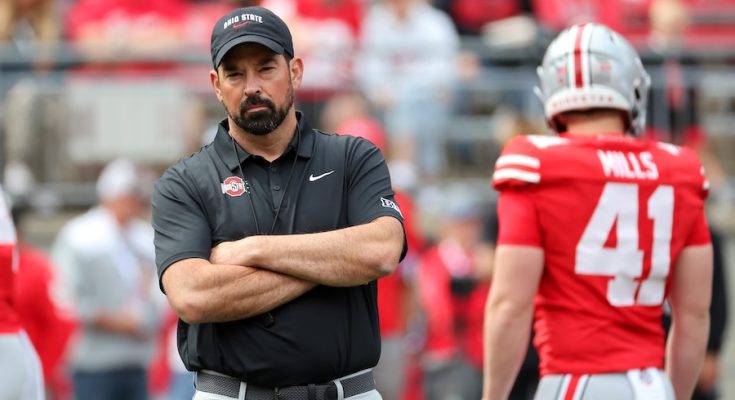By the end of the month, all eyes in the college football world are expected to turn to Auburn, where the head coach is anticipated to make a definitive choice that could reshape the future of the program. Rumors have been swirling for weeks about the potential decisions that may impact not only Auburn’s performance this season but also the long-term direction of the team. The anticipation has grown as analysts, fans, and insiders alike attempt to read between the lines of the subtle hints offered by the coaching staff, the athletic department, and even the players themselves. Every statement, every interview, and every sideline gesture has been scrutinized, with each minor detail becoming fodder for debate on social media platforms and sports talk shows across the nation.
The stakes are high for Auburn, a program that has historically prided itself on competitiveness within the Southeastern Conference, a league widely regarded as one of the toughest in college football. In recent years, Auburn has faced its share of challenges, from inconsistent recruiting classes to struggles in high-profile matchups against traditional rivals. The decision expected from the head coach by the end of the month is widely believed to involve key personnel moves, strategic shifts, or even a potential reevaluation of the program’s overall philosophy. Whatever choice is made, it will almost certainly have ripple effects across the SEC and the broader college football landscape.
Insiders report that the decision is not being taken lightly. The coaching staff has reportedly spent countless hours reviewing performance metrics, studying game film, and holding extensive meetings with coordinators, position coaches, and analysts. These deliberations indicate a thoughtful, deliberate process aimed at positioning Auburn for sustained success rather than a short-term reaction to the pressures of a single season. Sources close to the program suggest that the final decision may involve more than a simple personnel announcement—it could signal a reorientation of the team’s style of play, recruiting priorities, and even leadership hierarchy.
Auburn fans have been particularly vocal in expressing their hopes and concerns. Some are calling for bold, transformative action, urging the coach to make sweeping changes that could propel Auburn back into championship contention. Others advocate for stability, emphasizing the importance of continuity and trust in the existing roster and coaching structure. The debate is not merely theoretical; it reflects deep-seated emotions tied to decades of tradition, rivalries, and a passionate fan base that measures success not only in wins and losses but in the identity and culture of the program itself.
Recruiting implications are also at the forefront of this anticipated decision. College football operates on a cyclical rhythm, where the perception of program stability and ambition can influence the choices of elite high school athletes. Recruits pay close attention to the tone and direction set by the coaching staff, and a significant announcement could tip the balance in Auburn’s favor or, conversely, create uncertainty that some prospects might find concerning. Early indications suggest that the coaching staff has been proactive in communicating with current and prospective players, aiming to reassure them about the program’s vision and to ensure that the message remains consistent throughout the recruiting process.
Strategically, the decision could reflect a recalibration of Auburn’s approach to key aspects of the game. Some analysts speculate that adjustments could be made to offensive and defensive schemes, with an emphasis on modernizing play-calling, exploiting mismatches, and leveraging data-driven insights. Others suggest the decision could involve personnel shifts, including the elevation of assistant coaches to greater responsibilities or even the recruitment of high-profile transfers to address specific roster needs. Regardless of the specifics, the impending announcement is expected to send a clear signal to opponents, fans, and the wider college football community about Auburn’s priorities and ambitions moving forward.
Media coverage surrounding the impending decision has been intense. Sports networks have dedicated segments to analyzing every available clue, from press conferences to social media posts. Podcasts and online forums are filled with speculation, with enthusiasts offering predictions that range from the conservative to the highly speculative. Some reports have suggested that the decision could coincide with other announcements within the SEC, amplifying its significance and the potential for broader ramifications. The coverage underscores not only the prominence of Auburn within college football but also the high level of public interest in leadership decisions at major programs.
Players within the program have also been a source of insight, albeit cautiously. While official statements have been measured, interviews with key team members hint at an awareness of the magnitude of the forthcoming decision. Senior players, in particular, are reportedly focused on understanding how changes might affect team dynamics, their own roles, and opportunities for exposure in high-stakes games. Younger players are described as attentive, recognizing that the choices made by the coaching staff could shape their development and influence their future prospects in the sport. Within the locker room, discussions have reportedly been ongoing, reflecting a collective desire to align with the program’s vision while also maintaining team cohesion amid uncertainty.
The broader college football landscape is watching as well. Rival programs within the SEC are keenly aware that Auburn’s decisions could alter competitive dynamics, influence recruiting battles, and shift the balance of power within the conference. Coaches at neighboring institutions have been reportedly monitoring developments closely, preparing contingency plans and adjusting strategies based on the anticipated outcome. This level of attention underscores the interconnected nature of college football, where a single decision at one program can have cascading effects throughout the sport.
Historical context also adds weight to the situation. Auburn has experienced pivotal moments in the past where coaching decisions have had lasting impacts, shaping the trajectory of the program for years. Alumni and former players often reference these moments as benchmarks, comparing current deliberations to past successes and failures. The anticipation surrounding the upcoming choice reflects both the historical significance of leadership decisions at Auburn and the high expectations placed on those entrusted with guiding the program.
Financial and institutional considerations are not overlooked. College football programs operate within complex ecosystems, where coaching decisions can influence donor engagement, sponsorships, and ticket sales. Athletic departments monitor these factors closely, understanding that leadership choices resonate beyond the field. In Auburn’s case, the upcoming decision is expected to be coordinated with administrative stakeholders, ensuring alignment with the program’s broader mission and long-term objectives. The careful calibration of messaging, timing, and strategic priorities reflects a comprehensive approach aimed at optimizing both competitive and institutional outcomes.
Public engagement has also reached a fever pitch. Social media platforms are flooded with fan reactions, ranging from calls for bold moves to appeals for caution. Online polls, comment threads, and fan communities are active with speculation and debate, illustrating the depth of investment in Auburn’s future. Local media outlets have amplified these voices, providing platforms for community discussion while also reporting on behind-the-scenes developments. The convergence of fan interest, media scrutiny, and institutional strategy highlights the multifaceted nature of leadership decisions in modern college football.
Despite the intensity surrounding the decision, sources suggest that the coaching staff is approaching the situation with deliberation and focus. Reports indicate that multiple scenarios have been analyzed, potential outcomes weighed, and contingency plans prepared. The goal appears to be a decision that balances immediate performance needs with sustainable program growth, reflecting both competitive ambition and institutional responsibility. Whether the final choice involves tactical adjustments, personnel shifts, or broader philosophical changes, it is expected to be communicated clearly and decisively to all stakeholders.
In conclusion, the anticipation surrounding Auburn’s upcoming coaching decision has captured the attention of the college football world. By the end of the month, when the choice is finally revealed, fans, players, and analysts alike will have their expectations confirmed, challenged, or reshaped. The impact of this decision is likely to extend far beyond a single game or season, influencing recruiting, competitive dynamics, and the cultural identity of the program for years to come. As the countdown continues, Auburn stands at a crossroads, with a momentous decision looming that promises to define the trajectory of one of college football’s most storied programs. Every eye will be on the announcement, every analyst will dissect its implications, and every fan will hold their breath, knowing that the ramifications of the choice will be felt across the SEC and the entire college football landscape. The final decision promises not only clarity but also the potential for excitement, controversy, and renewed hope for Auburn’s future.



